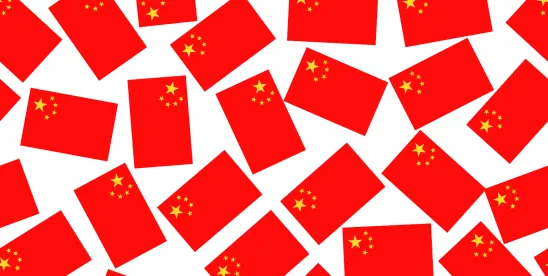In the current economic climate, the obvious focus of many companies is on the administration’s imposition of tariffs. However, government contractors, especially those contracting with the U.S. Department of Defense (“DoD”), must not lose sight of their current and potential future direct and indirect relationships with certain Chinese entities.
Contractors’ compliance obligations regarding relationships with Chinese entities flow from:
- FAR 52.204-25 (Section 889 of the 2019 National Defense Authorization Act (“NDAA”)), and
- The Chinese Military Companies (“CMC”) List (Section 1260H of the 2021 NDAA) (also known as the “1260H List”).
Section 889 became effective in 2019 and 2020, so compliance policies and procedures applicable to contracting with all federal government agencies should be well in place. New complexities are emerging for defense contractors given the expanding number of Chinese entities on the1260H List. All contractors are required to annually certify compliance with Section 889, but defense contractors will have an additional level of compliance. They will be required to comply with the 1260H List beginning in June 2026 (for contractors that work with individuals or entities that lobby for CMCs) and June 2027 (for contractors sourcing from or otherwise doing business with entities on the 1260H list). We discuss both compliance frameworks below and provide several key takeaways for contractors.
Government-Wide Supply Chain Restrictions: Section 889
Parts A and B of Section 889 impose significant restrictions on a contractor’s ability to use and sell to the government covered telecommunications and video surveillance products and services (“covered equipment and services”) from five Chinese entities and their affiliates.
Part A, effective August 2019, prohibits the government from procuring covered equipment and services manufactured by the companies identified below. A prime contractor is required to flow down this prohibition to its subcontractors. Part B, effective August 2020, prohibits the government from contracting with entities that “use” covered equipment and services from the five identified companies. This prohibition applies to a contractor’s use of covered equipment and services in any part of its business. There is no nexus required tethering the use of such equipment or services to the contractor’s performance of a federal government contract. Part B does not flow down to subcontractors.
As U.S. government contractors are now well aware, compliance with Part B requires eliminating covered technology and services from their organizations from the five named Chinese entities and their affiliates, which typically include the following types of products/services:
- Huawei: mobile phones, laptops, tablets, routers, and switches
- ZTE Corporation: mobile phones, mobile hotspots, and network equipment (routers/switches)
- Hytera Communications Corporation: radio transceivers and radio systems
- Dahua Technology Company & Hangzhou Hikvision Digital Technology: video surveillance products and services (e.g., company surveillance systems)
DoD-Only Relationship Restrictions on Companies Listed on the Section 1260H List
The 2021 NDAA will add a second layer of compliance only for defense contractors. The Secretary of Defense is required to publish an annual list of CMCs. Starting in June 2026, DoD will be prohibited from procuring goods, services, and technology produced or developed by listed CMCs or companies that hire lobbyists that lobby for CMCs. Starting in June 2027, the same prohibition will apply to indirect procurements, meaning defense contractors must eliminate goods, services, and technology from listed CMCs from their supply chains.
To be included on the 1260H List, a Chinese entity must have one of two associations as determined by DoD. First, an entity must directly or indirectly (whether through ownership, control, or affiliation) act as an agent of the People’s Liberation Army; Chinese military or paramilitary elements; security, police, law, or border enforcement; the People’s Armed Police; the Ministry of State Security; or any other organization controlled by the Central Military Commission of the Communist Party, the Ministry of Industry and Information Technology, the State-Owned Assets Supervision and Administration Commission of the State Council, or the State Administration of Science, Technology, and Industry for National Defense. Alternatively, listed entities are those important to civilian and military advancements in China’s defense industrial base; these entities are called “military-civil fusion contributors.”
Whereas compliance regimes for Section 889 are nearly five years old, compliance deadlines for Section 1260H are upcoming:
- Starting June 30, 2026, DoD may not (i) enter, renew, or extend contracts for goods, services, or technology with listed entities or their affiliates, or (ii) contract with companies that engage individuals or entities that lobby for CMCs, even if regulated “lobbying” activity does not relate to the contractor’s operations (Section 851 of the 2025 NDAA). (“Lobbying” is defined by the Lobbying Disclosure Act of 1995).
- The prohibition differentiates between end-item technology and mere “components” of end item technologies. The prohibition focuses on end-items. (“Component” means an item supplied to the Federal Government as part of an end-item or of another component. 41 U.S.C. § 105.)
- Starting June 30, 2027, DoD may not purchase end products or services developed or produced by listed entities indirectly through third parties. (Note an exception in Section 805 of the 2025 NDAA excluding the purchase of component materials that are part of an end product created by an entity not on the 1260H list.)
Section 1260H of the Fiscal Year 2021 NDAA required that DoD publish the 1260H List each year until at least 2030. Additional entities have been added each year thereafter. In an effort to provide contractors with ample notice, DoD has begun publishing 1260H Lists. As of January 2025, there are 134 entities on the list (Notice of Availability of Designation of Chinese Military Companies (Federal Register)). The listed entities span an array of industries, including telecommunications, aerospace, semiconductors, artificial intelligence, energy, and transportation, among others. Notably, Hangzhou Hikvision Digital Technology Co., Ltd. (Hikvision); Huawei Technologies Co., Ltd.; and Zhejiang Dahua Technology Co., Ltd. (Dahua) appear on both the Section 889 and Section 1260H lists.
Key Takeaways for Contractors
- For Section 889 and Section 1260H compliance, U.S. government contractors must assess their supply chains both for direct contracts as well as contracting for end products or services developed or produced by listed entities indirectly through third parties on either list.
- For purposes of Section 1260H, contractors must assess whether existing sourcing relationships involve “components” of end items (which are exempted) or end items themselves.
- Further, contractors must conduct extensive due diligence to understand the agents working with them and on behalf of any listed entity to avoid running afoul of the restrictions on lobbying activity.
- Contractors should actively monitor this space because more stringent restrictions may follow.




 />i
/>i

